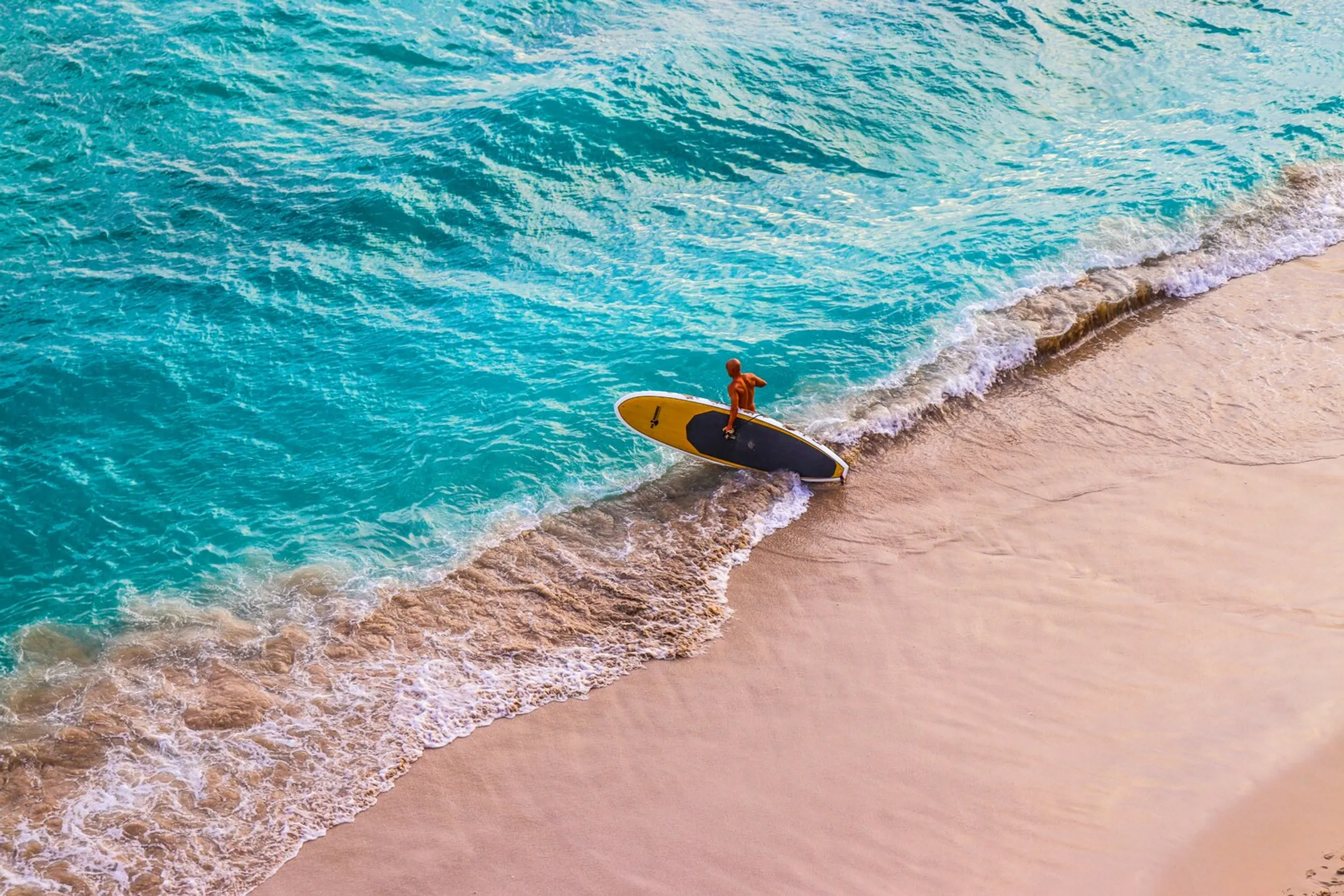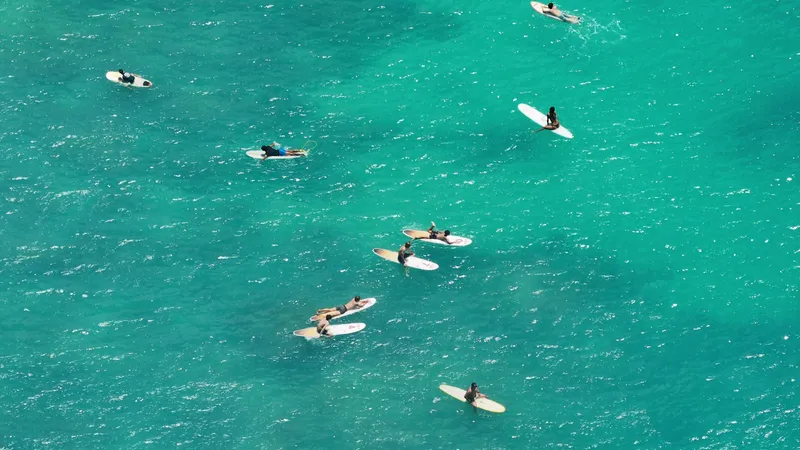

Ocean IQ: Safety & Respect
Master the unspoken rules and stay safe in Hawaiian waters - your guide to surf etiquette and ocean safety

Written by a Local Surf Expert
Jade KawanuiThe Golden Rule: When in Doubt, Don't Go Out
The Hawaiian ocean gives us the ultimate gift, but it doesn't suffer fools. Its beauty is matched by its power, and understanding its rhythms and its rules is the foundation of a safe and joyful experience. This is not just about avoiding physical danger. It's about navigating the complex social dynamics of the lineup with respect and humility.
The most important safety tip is also the simplest: "When in doubt, don't go out". If the conditions look beyond your ability, they are. There is no shame in sitting on the beach and watching.

The Unspoken Rules of the Lineup
Every surf spot in the world operates on a set of unwritten rules. In Hawaii, where the waves are more powerful and the lineups more crowded, following this etiquette is paramount.
🌊 Right of Way
The most fundamental rule. The surfer who is closest to the peak (the breaking part of the wave) has priority. If you are paddling for a wave and see another surfer on your inside (closer to the peak), it is their wave. You must pull back.
🚫 Don't Drop In
This is the cardinal sin of surfing. Dropping in means taking off on a wave that another surfer is already up and riding. It is extremely dangerous, as it can lead to collisions and serious injury, and it is the ultimate sign of disrespect. Always look both ways before you commit to a wave.
🐍 Don't Snake
Snaking is aggressively paddling around another surfer to steal the inside, priority position. It is considered greedy and rude, and it disrupts the natural flow and order of the lineup.
🏄♂️ Paddle Out Wide
When you are paddling back out to the lineup after riding a wave, do not paddle through the main surf zone where others are riding. Paddle wide, through the channel or the whitewater, to stay out of the way. If you get caught inside, it is your responsibility to get out of the path of an oncoming rider, even if it means taking the wave on the head.
🛡️ Control Your Board
Your surfboard is a large, hard object that can cause serious injury. Never ditch your board and let it fly. Always maintain control. Learning to turtle roll (for longboards) or duck dive (for shortboards) is essential for getting under breaking waves safely.
Ready to Surf Safely?
Learn the complete guide to Hawaiian surf culture and find your perfect wave
✅ Safety Checklist
- Check conditions & weather
- Know your limits
- Surf with others
- Use a leash
- Respect locals
⚠️ Ocean Hazards
Coral cuts easily - never stand on reef
Swim parallel to shore if caught
Watch for black spiny wana on reef
Waves are bigger than they look
🤙 Show Respect
- Be humble & patient
- Start on the shoulder
- Share waves generously
- Apologize for mistakes
- Learn the local culture
Respect Gets Respect: Understanding Hawaiian "Localism"
The topic of "localism" is often misunderstood and sensationalized. To navigate it successfully, you must approach it not as a threat, but as a teachable moment in cultural respect. The protective attitude found in some Hawaiian lineups is not born from simple aggression. It is a complex issue deeply rooted in history and cultural preservation.
For many Native Hawaiians, surfing is a sacred practice that was nearly eradicated by colonization and is now the centerpiece of a multi-billion dollar tourism industry. The feeling that this precious cultural resource must be protected from being overwhelmed is understandable.
As a visitor, you are a guest in these waters. Showing respect is not just polite. It is essential.
Essential Guidelines for Respectful Surfing
🙏 Be Humble
You are not in your home break. Do not paddle straight to the peak and act like you own the place.
👀 Start on the Shoulder
When you first paddle out at a new spot, sit on the periphery of the main takeoff zone. Watch the lineup. Observe its rhythm, see who the regulars are, and understand how the wave works before trying to catch one.
⏳ Wait Your Turn & Give Waves
Patience is a virtue. Don't be greedy. Let waves pass, especially if a local has been waiting. A simple head nod, a shaka, or a smile acknowledges their presence and shows you are not there to take over.
🙏 Apologize When You're Wrong
If you make a mistake, like an accidental drop-in, apologize immediately, clearly, and sincerely. Humility goes a long way.
💬 Communicate
In a crowded lineup, communication is key. A simple "Are you going left?" or a call of "Right!" if you're on a split peak can prevent collisions and shows you are aware of those around you.
Physical Hazards of the Hawaiian Ocean
🌊 Powerful Surf and Rip Currents
Hawaiian waves pack more punch than waves of a similar size elsewhere. This is due to the deep ocean trenches surrounding the islands and the lack of a continental shelf to slow the swells down.
Rip currents are strong channels of water that can pull you away from shore with surprising speed. If caught in one, do not panic and do not fight it by swimming directly to shore. Stay calm, float, and swim parallel to the beach until you are out of the current's pull, then angle back to shore.
🪨 Sharp Reef and Rocks
Most of Hawaii's best waves break over shallow, live coral reef. This reef is incredibly sharp and can cause serious cuts and infections ("reef rash").
Never intentionally stand on or touch the reef. You will damage a fragile ecosystem and likely injure yourself.
🦈 Marine Life
While shark attacks are exceedingly rare, it's wise to be aware. Avoid surfing in murky water, especially near river mouths or at dawn and dusk.
A more common hazard is the wana, or sea urchin, whose spines can easily puncture the skin if you step on the reef.
⚠️ The Golden Rule
The most important safety tip is also the simplest: "When in doubt, don't go out". If the conditions look beyond your ability, they are. There is no shame in sitting on the beach and watching.
Remember that respect is a two-way street. Most Hawaiian surfers are incredibly welcoming to visitors who show genuine aloha and respect for the ocean and local culture. A smile, a shaka, and humble attitude will open more doors than any amount of surfing skill.

